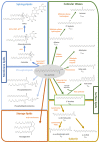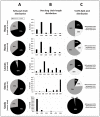Biosynthesis and Functions of Very-Long-Chain Fatty Acids in the Responses of Plants to Abiotic and Biotic Stresses
- PMID: 34064239
- PMCID: PMC8224384
- DOI: 10.3390/cells10061284
Biosynthesis and Functions of Very-Long-Chain Fatty Acids in the Responses of Plants to Abiotic and Biotic Stresses
Abstract
Very-long-chain fatty acids (i.e., fatty acids with more than 18 carbon atoms; VLCFA) are important molecules that play crucial physiological and structural roles in plants. VLCFA are specifically present in several membrane lipids and essential for membrane homeostasis. Their specific accumulation in the sphingolipids of the plasma membrane outer leaflet is of primordial importance for its correct functioning in intercellular communication. VLCFA are found in phospholipids, notably in phosphatidylserine and phosphatidylethanolamine, where they could play a role in membrane domain organization and interleaflet coupling. In epidermal cells, VLCFA are precursors of the cuticular waxes of the plant cuticle, which are of primary importance for many interactions of the plant with its surrounding environment. VLCFA are also major components of the root suberin barrier, which has been shown to be fundamental for nutrient homeostasis and plant adaptation to adverse conditions. Finally, some plants store VLCFA in the triacylglycerols of their seeds so that they later play a pivotal role in seed germination. In this review, taking advantage of the many studies conducted using Arabidopsis thaliana as a model, we present our current knowledge on the biosynthesis and regulation of VLCFA in plants, and on the various functions that VLCFA and their derivatives play in the interactions of plants with their abiotic and biotic environment.
Keywords: Arabidopsis; elongation complex; sphingolipids; stress response; surface lipids; very-long-chain fatty acids.
Conflict of interest statement
The authors declare no conflict of interest.
Figures



Similar articles
-
3-ketoacyl-CoA synthase 19 contributes to the biosynthesis of seed lipids and cuticular wax in Arabidopsis and abiotic stress tolerance.Plant Cell Environ. 2024 Dec;47(12):4599-4614. doi: 10.1111/pce.15054. Epub 2024 Jul 23. Plant Cell Environ. 2024. PMID: 39041727
-
Arabidopsis 3-ketoacyl-coenzyme a synthase9 is involved in the synthesis of tetracosanoic acids as precursors of cuticular waxes, suberins, sphingolipids, and phospholipids.Plant Physiol. 2013 Jun;162(2):567-80. doi: 10.1104/pp.112.210450. Epub 2013 Apr 12. Plant Physiol. 2013. PMID: 23585652 Free PMC article.
-
Tetracosanoic acids produced by 3-ketoacyl-CoA synthase 17 are required for synthesizing seed coat suberin in Arabidopsis.J Exp Bot. 2024 Mar 14;75(6):1767-1780. doi: 10.1093/jxb/erad381. J Exp Bot. 2024. PMID: 37769208
-
Synthesis of C20-38 Fatty Acids in Plant Tissues.Int J Mol Sci. 2022 Apr 25;23(9):4731. doi: 10.3390/ijms23094731. Int J Mol Sci. 2022. PMID: 35563119 Free PMC article. Review.
-
Very long chain fatty acid and lipid signaling in the response of plants to pathogens.Plant Signal Behav. 2009 Feb;4(2):94-9. doi: 10.4161/psb.4.2.7580. Plant Signal Behav. 2009. PMID: 19649180 Free PMC article. Review.
Cited by
-
KLU/CYP78A5, a Cytochrome P450 Monooxygenase Identified via Fox Hunting, Contributes to Cuticle Biosynthesis and Improves Various Abiotic Stress Tolerances.Front Plant Sci. 2022 Jun 23;13:904121. doi: 10.3389/fpls.2022.904121. eCollection 2022. Front Plant Sci. 2022. PMID: 35812904 Free PMC article.
-
A BrLINE1-RUP insertion in BrCER2 alters cuticular wax biosynthesis in Chinese cabbage (Brassica rapa L. ssp. pekinensis).Front Plant Sci. 2023 Jul 12;14:1212528. doi: 10.3389/fpls.2023.1212528. eCollection 2023. Front Plant Sci. 2023. PMID: 37502704 Free PMC article.
-
Genome-wide analysis of the KCS gene family in Medicago truncatula and their expression profile under various abiotic stress.Sci Rep. 2025 May 7;15(1):15938. doi: 10.1038/s41598-025-00809-6. Sci Rep. 2025. PMID: 40335581 Free PMC article.
-
Genome-wide analysis of KCS family in Medicago reveals MsKCS5's crucial role in abiotic stress adaptation.Plant Cell Rep. 2025 Jul 27;44(8):181. doi: 10.1007/s00299-025-03571-1. Plant Cell Rep. 2025. PMID: 40715510
-
An ancestral role for 3-KETOACYL-COA SYNTHASE3 as a negative regulator of plant cuticular wax synthesis.Plant Cell. 2023 May 29;35(6):2251-2270. doi: 10.1093/plcell/koad051. Plant Cell. 2023. PMID: 36807983 Free PMC article.
References
-
- Roudier F., Gissot L., Beaudoin F., Haslam R., Michaelson L., Marion J., Molino D., Lima A., Bach L., Morin H., et al. Very-Long-Chain Fatty Acids Are Involved in Polar Auxin Transport and Developmental Patterning in Arabidopsis. Plant Cell. 2010;22:364–375. doi: 10.1105/tpc.109.071209. - DOI - PMC - PubMed
-
- Trinh D.-C., Lavenus J., Goh T., Boutté Y., Drogue Q., Vaissayre V., Tellier F., Lucas M., Voß U., Gantet P., et al. PUCHI Regulates Very Long Chain Fatty Acid Biosynthesis during Lateral Root and Callus Formation. Proc. Natl. Acad. Sci. USA. 2019;116:14325–14330. doi: 10.1073/pnas.1906300116. - DOI - PMC - PubMed
Publication types
MeSH terms
Substances
Grants and funding
LinkOut - more resources
Full Text Sources
Other Literature Sources

